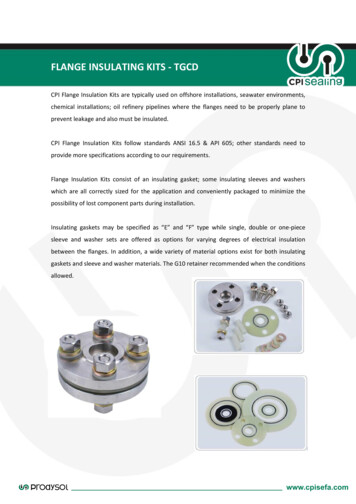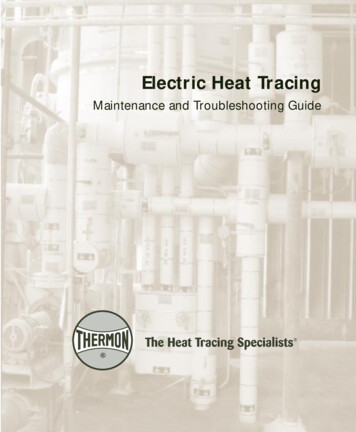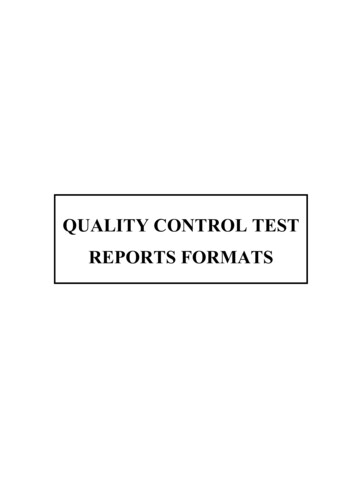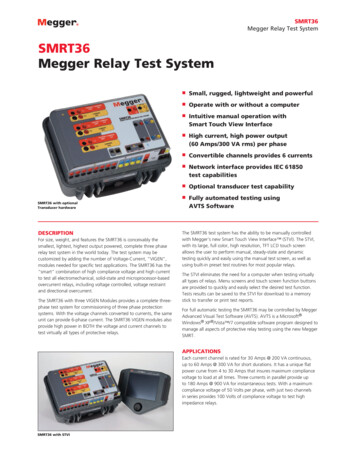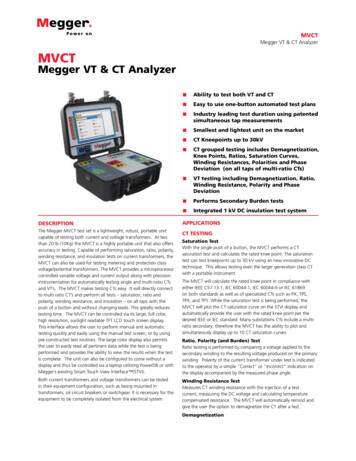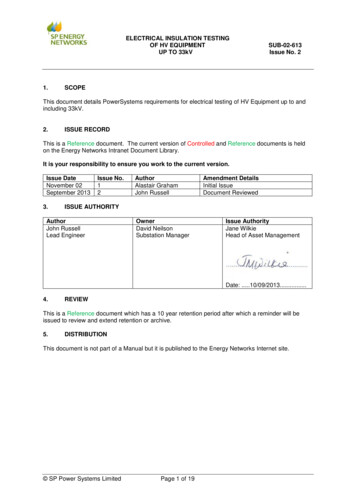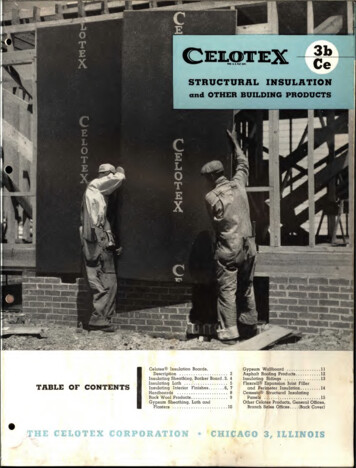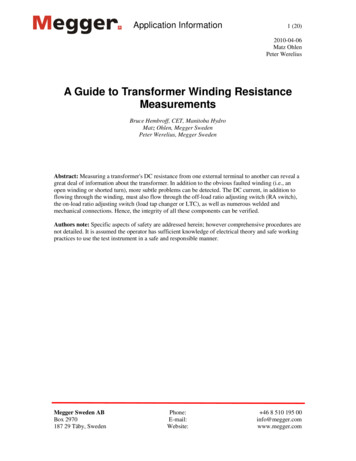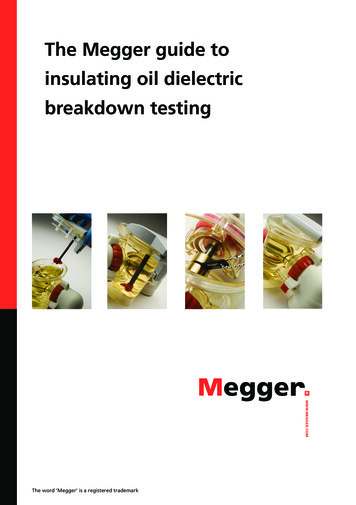
Transcription
The Megger guide toinsulating oil dielectricbreakdown testingWWW.MEGGER.COMThe word ‘Megger’ is a registered trademark
Contents1. Introduction. 32. What are the methods for testing oil?. 33.What is oil dielectric breakdown voltage testing?. 44. Who needs to perform dielectric breakdown voltage tests?. 45. Which types of insulating oil can be tested?. 46. Why, when and how often is oil testing performed?. 67.8.What are the test standards and their differences?. 67.1ASTM standards (USA). 87.2IEC standards (international). 9How should an oil sample be taken?. 109. Preparing the test vessel. 1210. Why measure oil sample temperature?. 1311. How do I know whether my test results are valid?. 1412. How do I know if my fluid has passed the test?. 1412.1USA – ASTM and IEEE standards. 1512.2International IEC standards. 1513. Can new oil fail a dielectric breakdown test?. 1614. Can I verify my test instrument performance?. 1715. How do oil test sets detect dielectric breakdown?. 1715.1Testing silicone oil. 1816. Choosing an oil dielectric breakdown voltage test set. 1816.1On-site versus laboratory testing. 1816.2General instrument selection considerations. 1816.3Selection considerations specific to laboratory instruments. 2416.4Selection considerations specific to portable instruments. 2517. Megger OTS range summary. 27AcknowledgmentsMegger gratefully acknowledges the support of John Noakhes of TJ/H2b Analytical Services for his help in compiling this publication.2www.megger.comThe Megger guide to insulating oil dielectric breakdown testing
1.IntroductionOils that combine a high flashpoint with high dielectric strength have long been used as an insulating medium intransformers, switchgear and other electrical apparatus. To ensure that the dielectric strength of the oil does notdeteriorate however, proper maintenance is essential, and the basis of proper maintenance is testing.For over 100 years, Megger has been a world leader in the development and manufacture of test equipment forelectrical power applications. The famous Megger trademark was first registered in 1903, and jealously guardedby the company. Megger’s experience in the design and production of oil test sets also reaches back to the early20th century, when pioneering equipment was produced by Foster Transformers, a company that became part ofMegger Group in 1968.Today, all of Megger’s oil test set design, development and manufacture is carried out at the company’smanufacturing facility in Dover, England.2.What are the methods for testing oil?For in-service equipment in particular, there are many test techniques for evaluating the condition of the insulatingoil. If the technique of dissolved gas analysis is excluded, oil tests can be divided into two basic groups.The first group includes tests that are concerned with the immediate condition and acceptability of the insulationin an item of electrical equipment. This group includes dielectric breakdown voltage testing as well as moisturemeasurement by the Karl Fischer (KF) method, and determination of insulation condition by measuring the dielectricdissipation factor.The Megger OTS range of dielectric breakdown voltage test setsThe Megger KF range of moisture content test setsThe Megger guide to insulating oil dielectric breakdown testingwww.megger.com3
The second group includes tests that look at the degree of degradation and aging of the equipment’s insulationsystem. These tests include interfacial tension, acidity (neutralisation value), resistivity and visual determination ofcolour and appearance of the insulating oil.Typical oil colour specimensThe darker the colour the more contaminants presentGoodFairBadWhile all of these tests are useful in particular circumstances, the most convenient and most universally applicable isdielectric breakdown voltage testing, which is why it has been selected as the subject of this technical guide.3.What is oil dielectric breakdown voltage testing?Put simply, a dielectric breakdown voltage test is a measure of the electrical stress that an insulating oil canwithstand without breakdown. The test is performedusing a test vessel that has two electrodes mounted in it, with a gap betweenthem. A sample of the oil to be tested is put into the vessel and an ac voltage isapplied to the electrodes. This voltage is increased until the oil breaks down –that is, until a spark passes between the electrodes. The test voltage is thenimmediately turned off. The voltage at which breakdown occurred is the testresult, and is typically evaluated by comparing it with guidelines set out in variousstandards, or in the oil manufacturer’s specifications.The exact method of performing the test is determined by the standard that is being used, as will be explained later.The standard typically defines parameters such as the size and shape of the electrodes, the gap between them, therate at which the test voltage is increased, how many times the test is repeated and whether or not the oil is stirredduring the test.4.Who needs to perform dielectric breakdown voltage tests?There are many types of organisation that benefit from carrying out tests on transformer oil. These include: Utility contractors (principally in substations) Utility companies (principally in power stations) Rail companies (locomotive HV step-down transformers and switchgear) Oil test laboratories (providing testing services) Transformer and switchgear manufacturers (quality control of oil) Oil companies (testing new oil during manufacture)5.Which types of insulating oil can be tested?While the generic term ‘oil’ is almost universally used to describe insulating fluids, there are currently five differenttypes of insulating fluid in common use. These are: Mineral oil4 High molecular weight hydrocarbon (HMWH) fluids Silicone fluids Synthetic ester fluids Natural ester (vegetable oil) fluidswww.megger.comThe Megger guide to insulating oil dielectric breakdown testing
All of these oil types can be tested for dielectric breakdown voltage and tested with Megger OTS range test sets.Mineral oil is the most common insulating fluid and has been in use since the late 19th century. There are manymineral oil filled transformers that have been in continuous use for more than 50 years. Mineral oils are refined fromeither naphthenic crude or more recently, from paraffinic crude.HWMH, silicon, synthetic ester and natural ester fluids are more recent developments and are often preferredbecause they are much less flammable than mineral oil. ASTM D5222 specifies that for insulating fluids to qualifyas ‘less flammable’ they must have a fire point of at least 300 ºC.The five fluids differ significantly in the way they behave in the presence of moisture. Mineral oil is the leastsatisfactory, and even small amounts of water significantly reduce its breakdown voltage. Silicone fluid is also quicklyaffected by small amounts of moisture, whereas ester fluids behave very well in the presence of moisture and cantypically maintain a breakdown voltage of greater than 30 kV with more than 400 ppm water content. This is one ofthe reasons that esters last much longer in service.This table is not exhaustive, but does give a good indication of the types of insulating fluid that are used in variousapplications. It also shows which types of fluid can be tested with the Megger OTS range of dielectric breakdownvoltage test sets.EquipmentFluid TypeExample/Sub-typeCan be tested with Megger OTSrange?Synthetic aromatic hydrocarbonsPXEYesAromatic estersVarious typesYesCapacitorsMedium and high voltagecablesNewSynthetic hydrocarbonsPolybutenesYesOldMineral oilVarious typesYesBushingsMineral oilVarious typesYesOil filled circuit breakersMineral oilVarious typesYesMineral oilShell Diala AXYesPerflurocarbon (PFC)3M PF-5060YesHigh molecular weight(HMW) oilVarious typesYesDow Corning 561YesSynthetic hydrocarbonsPolyalohaolefins (PAOs)YesSynthetic polyol estersEnvirotemp 200YesVegetable oils - natural esterEnvirotemp FR3YesHydroflurocarbonVertrel VXYesPCBs - PolychlorinatedbiphenylsAskarel Pyranol Phenochlor No - Harzardous - requires specialhandlingAskarel (contained 50%)Wecosol No - Harzardous - requires specialhandlingSF6NoSiliconeLow flammabilityfluidsTransformersOld fluidsTetrachloroethylene/perchloroethylene (PCE)LTC (Load Tap Changers)GasesSulphur HexafluorideOld gasesFreon R-113Mineral oilThe Megger guide to insulating oil dielectric breakdown testingVapotransNoVarious typesYeswww.megger.com5
6.Why, when and how often is oil testing performed?6.1Why and when?The dielectric breakdown voltage test is a relatively quick and easy way of determining the amount of contaminationin insulating oil. Usually the contaminant is water, but it can also be conductive particles, dirt, debris, insulatingparticles and the by-products of oxidation and aging of the oil.For in-service equipment, the dielectric breakdown voltage test offers a useful and convenient way to detectmoisture and other contamination in the oil before it leads to a catastrophic failure. The information gained fromthe test can also be used as an aid to: Predicting the remaining life of a transformer Enhancing operational safety Preventing equipment fires Maintaining reliabilityDielectric breakdown voltage testing is also carried out on new oil before it is used to fill equipment, and as part ofthe acceptance testing for deliveries of new and reprocessed oil.6.2How often?Dielectric breakdown voltage testing is an important element in the maintenance programme of any item of oilinsulated electrical equipment. However, to get the maximum benefit from this type of testing, Megger stronglyrecommends that the oil is tested at least once a year and preferably twice a year. The results should be recorded,as trending the data will make it easier to identify sudden or unexpected changes. If a sudden change in the resultsis found, the transformer can be inspected for leaks, the oil level can be checked and the water content of the oilevaluated. If contamination is confirmed, it will often be possible to dry and filter the oil, thereby reconditioning itrather than having to replace it with expensive new oil.50BDV (kV)45403530252017.23456Period between tests (e.g. years)78What are the test standards and their differences?There are many test standards for insulating liquids, but they are derivatives of three main standards. Two of theseare from ASTM International (USA) and the other is from the IEC (Europe). These main standards are: ASTM D877 – Standard Test Method for Dielectric Breakdown Voltage of InsulatingLiquids Using Disk Electrodes. ASTM D1816 – Standard Test Method for Dielectric Breakdown Voltage of InsulatingOils of Petroleum Origin Using VDE Electrodes. IEC 60156 Insulating Liquids – Determination of the breakdown voltage at powerfrequencies – Test method. There is also a Japanese standard not based on these ASTM or IEC standards.The following table is not exhaustive, but it shows the main differences between the ASTM and IEC standards.6www.megger.comThe Megger guide to insulating oil dielectric breakdown testing
StandardsASTM D1816Procedure BUSAUSAUSAGap size2 mm or 1 mm*2.54 mm2.54 y testtemperatureLiquidAmbientTest voltageBreakdownsTest voltageswitch offtime followingbreakdownIEC 60156EuropeShapeOil sample stirringOutside testtemperatureASTM D 877Procedure A2.5 mmoptionalnot stirrednot stirredAt ambient - mustrecord20 - 30 ºC mustrecord temperatureas collected andwhen tested20 - 30 ºC mustrecord temperatureas collected andwhen tested15 - 25 ºCfor referee testsno optionoptional20 - 30 ºCMust recordMust recordWithin 5 ºC of oil sampleAt ambient - mustrecordMust recordMust record15 - 25 ºCAmbientReferee tests 20 - 30 ºCMust recordMust recordWithin 5 ºC of oil sampleRise rate0.5 kV/s3 kV/s3 kV/s2 kV/sFrequency45 - 6545 - 6545 - 6545 - 62Definition 100 V 100 V 100 V4 mA for 5 msNumber insequence5**5*1 - 5 differentsamples6Timebetweenbreakdown1 to 1.5 min1 minn/a2 minNormal (e.g.mineral oil)Not specifiedNot specifiedNot specified 10 msSilicon oilNot specifiedNot specifiedNot specified 1 ms3 - 5 min2 - 3 min2 - 3 min2 minLiquidTime between filling and startof testEquivalent standards (adoptedinto)NoneNoneNoneCan be used ifmodified in accordancewith D2225 ifprocedure A cannotbe usedBS EN 60156CEI EN 60156IRAM 2341UNE EN 60156FN EN 6056SABE EN 60156VDE0370 part 5AS1767.2.1PA SEV EN 60156NRS 079-1*IS6729*Notes on testing silicon oilCan be used provided discharge energy insample 20 mjSpecial conditions* If breakdown doesnot occur at 2 mm,reduce gap to 1 mm** Tests must berepeated if range ofBD voltages recordedare more than 120%of mean with 1 mmelectrode gap and 92%of mean with 2 mmelectrode gap*Tests must be repeated if range of BDvoltages recorded are more than 92% ofmean. If range of 10 BD voltages is morethan 151% investigate whyExpected range of standard deviation/mean ratio as a function of the meanprovided as a chartCommentsTest vessel requirescover or baffle toprevent air fromcontacting circulating oilUsed if any insolublebreakdown productsin oil completelysettle betweenbreakdown tests*With some stand/stir timing differences.Test cell/vessel must be transparent.Reconditioned/reclaimed oil to BS148is tested to IEC60156 following updatein 2009.The Megger guide to insulating oil dielectric breakdown testingUsed if any insolublebreakdown productsdo not settlebetween breakdowntestsOK if test instrument can comply withvoltage switch off time requirementswww.megger.com7
There are many standards based on IEC 60156 and in addition Japanese standard JIS C2101 also includesrequirements for dielectric breakdown voltage testing. JIS C2101 calls for spherical electrodes similar to thosespecified by IEC 60156, but requires a different sequence of five breakdowns. JIS C2101-99 (M) for mineral oils callsfor two oil samples to be tested each with a sequence of five breakdown tests. JIS C2101-99 (S) for silicon oils callsfor a sequence five tests but each test is performed on a different sample of oil.7.1ASTM standards (USA)There are two standard test methods from ASTM International. The first is ASTM D877-02 (latest edition 2002) –Standard Test Method for Dielectric Breakdown Voltage of Insulating Liquids Using Disk Electrodes. The second isASTM D1816-04 (latest edition 2004) – Standard Test Method for Dielectric Breakdown Voltage of Insulating Oils ofPetroleum Origin Using VDE Electrodes. Although this is essentially an American standard, it borrows from VDE, aGerman standards organisation.ASTM D877ASTM D877 is an older standard, and is generally not very sensitive to the presence of moisture. For that reasonit is not widely used for in-service applications. In 2002 the IEEE revised C51.106, Guide for the Acceptance andMaintenance of Insulating Oil in Equipment the values from D877 were removed from their criteria for evaluatingin-service oil in transformers. Generally ASTM 877 is recommended only for acceptance testing of new oil receivedfrom a supplier, either in bulk loads or containers, to ensure the oil was correctly stored and transported. Typically aminimum breakdown value of 30 kV is specified.The ASTM D877 standard specifies the use of disc shaped electrodes that are 25.4 mm (1 inch) in diameter andat least 3.18 mm (0.125 inch) thick. These electrodes are made of polished brass and are mounted to have theirfaces parallel and horizontally in line in the test vessel. The edges are specified to be sharp with no more than a0.254 mm (0.010 inch) radius. The sharp edges should be regularly inspected to ensure that they have not becometoo rounded. Excessively rounded edges will have the effect of falsely raising the breakdown voltage, possiblypassing oil that should have failed the test. It is also important that the electrodes are kept very clean, with nopitting or signs of corrosion, otherwise breakdown values can be falsely low. Instrument users should regularlyinspect electrodes, cleaning and polishing as required.The Megger OTS instrument test set up screens for D877:ASTM D1816ASTM D1816 has become widely used over the years, even being used outside the standard’s stated application ofpetroleum origin insulating oils and viscosity limits. D1816 is more sensitive than D877 to moisture, oil aging andoxidisation, and is more affected by the presence of particles in the oil. When the IEEE revised C51.106 in 2002,breakdown voltage limits for new and in-service oil using D1816 were added.ASTM D1816 specifies the use of mushroom-shaped electrodes 36 mm in diameter. As with D877, the electrodesare made of brass must be polished to be free of any etching, scratching, pitting, or carbon accumulation. The oil isstirred throughout the test sequence, and a two-bladed motor-driven impellor is specified. The standard prescribesthe impellor dimensions and pitch as well as the operating speed, which must be between 200 rpm and 300 rpm.To prevent air coming into contact with the circulating oil, the test vessel must have a cover or baffle.8www.megger.comThe Megger guide to insulating oil dielectric breakdown testing
The D1816 standard, although generally accepted as more useful than D877, has got one significant limitation:when testing in-service oil this test method is very sensitive to dissolved gases. Excessive amounts of gas in the oilcan lower the test results to the point that a perfectly good sample of oil, with low moisture and particle content,will fail the test. It is important to bear this in mind when testing oil from small gas blanketed transformers andeven, in some cases, from free-breathing transformers.The Megger OTS instrument test set up screen for D1816:The insulating fluid manufacturer will usually quote typical breakdown values for both new and in-service fluid inthe insulating fluid data sheet. In addition the test standards will refer to another oil condition standard that willprovide guidance as to what is acceptable. Test houses will also provide guidance as to what is acceptable.7.2IEC standards (International)The International Electrotechnical Commission (IEC) defines only one method for oil breakdown dielectricvoltage testing. This is IEC 60156 Insulating Liquids – Determination of the Breakdown Voltage at PowerFrequencies – Test Method.IEC 60156IEC 60156 is an international standard that appears in many forms as IEC member national committees from variouscountries have adopted it. Examples are British Standard BS EN 60156 and German VDE 0370 part 5. IEC 60156specifies the use of (either spherical, or) mushroom (shaped) electrodes the same those used in the ASTM D1816standard. The IEC standard differs in a number of ways from D1816, but the main difference is the IEC standardallows the optional use of a stirring impeller, the use of a magnetic bead stirrer or even no stirring at all. The standardstates that differences between tests with or without stirring have not been found to be statistically significant. Theuse of a magnetic stirrer is only permitted when there is no risk of removing magnetic particles from the oil sampleunder test. When oil is used as a coolant and therefore circulating it would be stirred during testing. For example oilfrom a transformer normally circulates if it is used as coolant, so an oil sample taken here would normally be stirredto ensure the best chance of detecting particle contamination. Oil from a circuit breaker is normally static in use soparticles would naturally fall to the bottom where they are unlikely to cause a problem. So in static use applications,an oil sample would usually not be stirred.The dielectric breakdown values from the IEC 60156 method are usually higher than those from the ASTM methods.Possibly this is in part because of the differences in voltage ramp up speed and electrode gap compared withD1816, and electrode shape compared with D877. (The IEC electrode shape provides a more uniform electric field).The result is that for well-maintained transformers the breakdown voltages may be higher than a 60 kV testinstrument can reach.This may not be a problem when evaluating new oil from a supplier or even for in-service oil, but often an actualbreakdown voltage value is required. When testing to IEC 60156, therefore, the use of an instrument capable ofapplying a higher voltage is advisable. As with D1816, dissolved gas in the oil sample may reduce breakdown valuesbut the effect is much less pronounced than with the IEC 60156 standard.The Megger guide to insulating oil dielectric breakdown testingwww.megger.com9
Some Megger OTS instrument test set up screen examples for IEC60156:8.How should an oil sample be taken?Two things are particularly important when taking oil samples. The first is to ensure that the proper samplingprocedure is followed, and the second is to ensure that all of the essential information is properly recorded.If the sample is to be sent to a test house for testing, the test house should be able to advise on the informationneeded, but it’s important to bear in mind that the condition diagnosis will only be as good as the informationsupplied. The test house should also advise on the volume of the sample, and the type of container to use.For oil samples from transformers, this information that oil test laboratories generally require is: Description of the sample List of tests to be performed Transformer name plate information Type of transformer Type of insulating fluid Any leaks noted Insulating fluid service history (has it been dried, etc) Transformer service history (has it been rewound, etc) Type of breather Type of insulation, including temperature rise rating Details of cooling equipment (fans, radiators, etc) Temperature of top of fluid, read from gauge Actual fluid temperature measured Fluid level Vacuum and pressure gauge readingsFor load tap changers, it is also advisable to record the counter reading, the selector range and the sweep range.Sampling should be performed in accordance with the appropriate standard, and is not, therefore, discussed indetail in this technical guide.In the USA, there are two standards for sampling: D923 – Standard Practices for Sampling Electrical Insulating Liquids10 D3613 – Standard Practice for Sampling Electrical Insulating Oils for Gas Analysis and Determinationof Water Content Internationally, there are two further sampling standards:www.megger.comThe Megger guide to insulating oil dielectric breakdown testing
IEC 60475 Ed. 2.0 – Method of Sampling Insulating Liquids IEC 60567 Ed. 3.0 – Oil-filled electrical equipment – Sampling of gases and of oil for analysis of free anddissolved gases – GuidanceThe IEC standards should be consulted together, especially as part of IEC 60567 has been transferred to IEC 60475.8.1Hints and tips for taking oil samplesFor a sample to be truly useful, it must be representative of the oil in the equipment. This means that cleanliness isextremely important. Samples are normally drawn from a drain valve or sampling cock. This must be cleaned both insideand out before the sample is taken to ensure that dirt does not fall into the sampling container. The drain valve is at the bottom of the equipment, where all of the sludge, water and contaminantparticles collect. It is important therefore, to flush the system thoroughly to ensure that the sample isdrawn from the main bulk of the oil. This may involve removing two litres of oil, and even more if theequipment has been out of service for some time. Do not be tempted to use old engine oil bottles, even for a few p.p.m. of engine oil will cause thesample to fail a breakdown test. Do let the oil flow down the side of the sample bottle, or use a clean tube run to the bottom of thebottle; it will prevent air being mixed with the oil. Do store the oil samples in glass or clear plastic bottles in the dark, mineral oil will deteriorate ifexposed to UV light.Safety Before taking samples, ensure that you have all of the required permissions and permits Have everything you need to lock out/tag out to hand Make sure that the PCB (polychlorinated biphenyl) content of the oil, if any, is known and that theequipment is labelled. PCB is very hazardous and requires special handling Use all of the correct personal protective equipment (PPE) and correctly rated tools Check the area for electrical and tripping hazards Check for wildlife – snakes, bees, etc like transformers! Check that the transformer is under positive pressure – are the pressure gauges reliable? Could theybe blocked or broken? NEVER try to take a sample from a transformer under negative pressure. Aircould be drawn into the transformer and cause it to fail.Sampling equipment Take extra sample bottles and syringes – they’re often needed Ensure that the sample bottle seals are airtight Use only ground glass syringes If rubber hose is used, discard after each sample is takenA sampling syringeThe Megger guide to insulating oil dielectric breakdown testingwww.megger.com11
Flushing the system When flushing the system, a spare sample bottle is usually repeatedly filled and emptied into the waste.It is good practice to measure the oil temperature using the last bottle that will be discarded, as thisavoids having to put the thermometer into the actual sample.Taking the sample9. Wherever possible, try to take samples during times of relatively steady loads and temperature – in otherwords, when the equipment is at equilibrium. (This is particularly important with transformers, as if thesample happens to be taken after the transformer has cooled following a long period of running at fullload, the breakdown voltage of the oil will be much lower than normal. This is because moisture in thepaper insulation will have migrated to the oil during the period of full load, and will not yet have hadtime to migrate back. This is usually considered to be a normal phenomenon, but it is possible that itmay also be a factor in so-called ‘suddendeath’ transformer incidents where, for no apparent reason, aseemingly healthy transformer suddenly fails. This is another good reason for recording as much information about the transformer as possible and for trending results to look for unexplained changes). Do not take samples when it is raining or snowing, or when the relative humidity is above 50%, asthere is a high probability that samples taken in these conditions will be contaminated. Do not take samples when it is windy, as dust blown by the wind may contaminate the sample. Try not to take samples when the ambient temperature is high, as perspiration is a common source ofcontamination problems.Preparing the test vesselSuccessful dielectric breakdown voltage testing depends not only on obtaining a good sample, as discussed in theprevious section, but also on ensuring that the test vessel is properly prepared. The preparation of the test vessel can bedivided into two key elements – the first is storing, cleaning and filling, and the second is setting the electrode gap.9.1Storing and cleaning test vesselsIEC 60156 recommends that a separate test vessel assembly is used for each type of insulating fluid that it isrequired to test. This standard requires that the test vessels are filled with dry insulating fluid of the type that theywill be used to test, then covered and stored in a dry place. ASTM offers an alternative option of storing the vesselsempty in dust-free cabinet.Immediately prior to testing, vessels stored full must be drained and then all internal surfaces, including the electrodes,rinsed with fluid taken from the sample to be tested. The vessel should then be drained again, and carefully filledwith the test sample, taking particular care to avoid the formation of bubbles.If the vessel was stored empty, or if it is to be used for a different type of fluid from that with which it was filledduring storage, it should be cleaned with an appropriate solvent before the rinsing and fi
Put simply, a dielectric breakdown voltage test is a measure of the electrical stress that an insulating oil can withstand without breakdown. The test is performed using a test vessel that has two electrodes mounted in it, with a gap between them. A sample of the oil to be tested is put into the vessel and an ac voltage is


